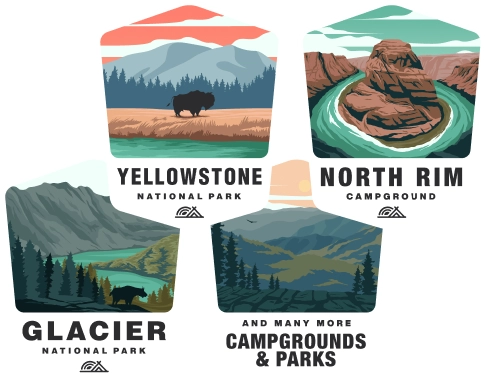Camping at Death Valley National Park
Overview of Death Valley National Park
Death Valley National Park, straddling eastern California and Nevada, is known for its extremes: It is North America's driest and hottest spot and has the lowest elevation on the continent. Despite its foreboding name, Death Valley offers a range of outdoor activities, beautiful landscapes, and a unique desert ecosystem.
Camping in Death Valley National Park
When to Camp: Death Valley's camping season typically peaks from fall to spring, with most campgrounds open from October through April. Summer temperatures can be dangerous, with daytime highs regularly exceeding 120°F (49°C). Cooler temperatures in the late autumn through early spring make these months the ideal time for your visit.
Where to Camp: Death Valley has several campgrounds:
- Furnace Creek Campground: The only campground in the park that takes reservations during the peak season. It has full facilities and some RV hookups.
- Sunset, Texas Spring, and Stovepipe Wells Village Campgrounds: These offer a mix of facilities, with some being first-come, first-served.
- Wilderness and Backcountry Camping: For a more secluded experience, you can opt for backcountry camping away from developed areas.
Facilities and Fees: Campgrounds in Death Valley National Park may provide various amenities such as restrooms, water, picnic tables, fire pits, and dump stations. Fees for camping vary by campground and are subject to change, so it's best to check the park's official website or contact the visitor center for the most up-to-date information. Entrance fees to the park are also required.
Camping Reservations and Permits
Reservations: Some campgrounds in Death Valley require reservations, which can usually be made in advance through the National Park Service's online reservation system, Recreation.gov. Campgrounds that operate on a first-come, first-served basis do not require reservations, but arriving early is recommended, especially during peak season.
Permits: Backcountry camping may require a free permit, which can typically be obtained at visitor centers or through self-registration at designated locations within the park. Always check with the park's visitor center for the latest backcountry camping regulations and recommendations.
Safety Tips and Regulations
- Water: In this extremely dry environment, staying hydrated is crucial. Carry and consume plenty of water—at least one gallon per person per day.
- Weather Conditions: Be prepared for extreme heat and cold, as daytime and nighttime temperatures can vary greatly.
- Wildlife: Keep a safe distance from wildlife. Never feed wild animals.
- Leave No Trace: Respect park rules and regulations, pack out all your trash, and leave the environment as you found it.
Points of Interest for Campers
While camping, don't miss out on the various attractions within the park:
- Badwater Basin: The lowest point in North America at 282 feet below sea level.
- Zabriskie Point: Offers one of the most spectacular views of the park, especially at sunrise or sunset.
- Dante's View: Provides a panoramic view of the valley from over 5,000 feet above.
- Artist's Palette: Known for its colorful soil created by various minerals.
- Mesquite Flat Sand Dunes: Accessible sand dunes near Stovepipe Wells.
Conclusion
Camping in Death Valley National Park offers an unforgettable adventure due to its unique climate and natural beauty. Planning, preparation, and following park guidelines are essential for a safe and enjoyable trip. Always keep abreast of current conditions and park alerts prior to your visit.
